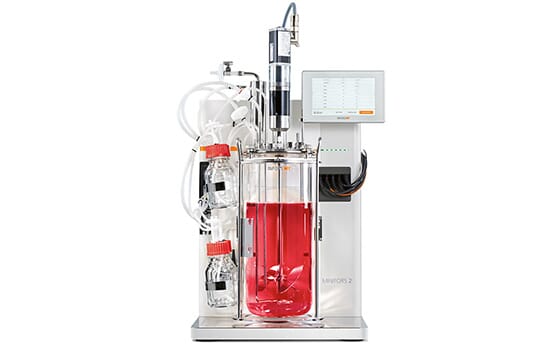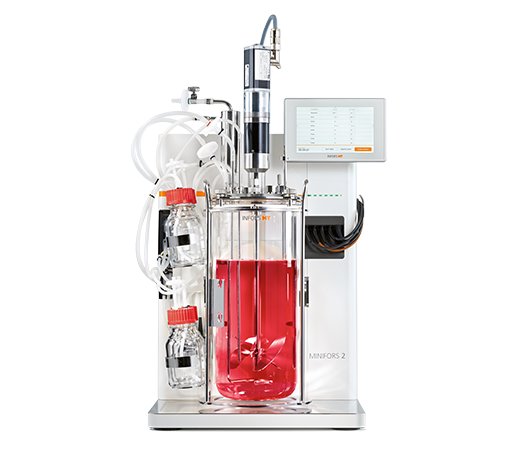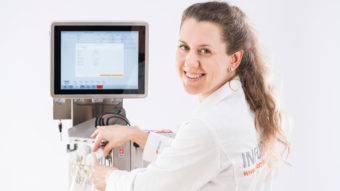Cell culture bioreactors

Culturing cells in a bioreactor requires gentle yet thorough mixing, a precise flow of gas and accurate monitoring and control. Sterility plays an important role as well in preventing contamination. Qualification is indispensable for bioreactors operated in a validated environment.
High-end gassing systems
Culturing cells requires precise control of the dissolved oxygen concentration. The ideal solution here is a complex gassing strategy involving air, N2 and O2, each with its own mass flow controller. Configuring cascades must be as intuitive a process as possible in order to adapt the pO2 control strategy to the needs of an individual application. An important factor here is making sure enough oxygen is available to cells—keeping the kLa value of the bioreactor high, in other words—despite the low, gentle gassing rate. The system also needs to include a CO2 line for pH control, as well as an option for headspace gassing.
Thorough mixing with little shear stress
Thorough mixing is indispensable for maintaining homogeneous conditions within the culture vessel. Short mixing periods reduce concentration gradients, which can damage cells and can arise, for instance, when introducing a base or nutrient medium. But because cells are highly sensitive to shear forces, the mixing system must use a suitable stirrer—one that mixes thoroughly with low power input and uniform energy distribution.Absolute sterility
Cell cultures are particularly susceptible to biological contamination. One bacterial spore or vegetative bacterial cell is all it takes to overgrow an animal cell culture. Critical contamination points for a bioreactor are the transitions between sterile spaces, such as the stirrer, ports and gas lines. Autoclavable bioreactors are usually equipped with multiple seals, aseptic sampling systems and autoclavable, single-use filters with hydrophobic PTFE membranes for sterilizing input and exhaust gasses.Continuous monitoring
Reproducible cell cultivation requires a detailed look inside the cultivation process. Additional sensors—for analyzing waste gas, measuring live cell density and biomass, etc.—allow users to monitor critical parameters continuously. On the basis of these data, bioprocess software can then continuously calculate additional parameters such as RQ, allowing the system to respond quickly and automatically to changing process conditions.Qualification
Work with cell cultures may mean having to qualify bioreactors and document experiments in accordance with GMP guidelines. Depending on a customer’s requirements, qualification may involve performing a factory acceptance test (FAT), site acceptance test (SAT), installation qualification (IQ) and operational qualification (OQ). Bioprocess software will document the entire culturing process, enabling automatic monitoring and control over a relatively long period of time.Your cell culture bioreactor
Contact us for one-on-one consultation.
Our benchtop bioreactors for cell cultures:

Minifors 2
The award-winning, all-in-one system for cell cultures
Vessels: 1,5 L - 6 L
- Gentle stirring system capable of reaching up to 600–1
- Optimum gassing with up to 5 MFCs
- Includes a “cookbook” explaining bioprocess fundamentals.

eve® – Bioprocess software for bioreactors
Workflow-oriented planning tools and comprehensive options for bioprocess control and monitoring
Location-independent monitoring and control of bioprocess parameters
Detailed reporting according to GMP
Validation according to FDA 21 CFR Part 11
«A gentle yet powerful system for mixing the culture medium is important for CHO, HeLa, HEK-293 and other cell culture lines.»





